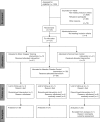Mental practice with motor imagery in stroke recovery: randomized controlled trial of efficacy
- PMID: 21515905
- PMCID: PMC3097892
- DOI: 10.1093/brain/awr077
Mental practice with motor imagery in stroke recovery: randomized controlled trial of efficacy
Abstract
This randomized controlled trial evaluated the therapeutic benefit of mental practice with motor imagery in stroke patients with persistent upper limb motor weakness. There is evidence to suggest that mental rehearsal of movement can produce effects normally attributed to practising the actual movements. Imagining hand movements could stimulate restitution and redistribution of brain activity, which accompanies recovery of hand function, thus resulting in a reduced motor deficit. Current efficacy evidence for mental practice with motor imagery in stroke is insufficient due to methodological limitations. This randomized controlled sequential cohort study included 121 stroke patients with a residual upper limb weakness within 6 months following stroke (on average <3 months post-stroke). Randomization was performed using an automated statistical minimizing procedure. The primary outcome measure was a blinded rating on the Action Research Arm test. The study analysed the outcome of 39 patients involved in 4 weeks of mental rehearsal of upper limb movements during 45-min supervised sessions three times a week and structured independent sessions twice a week, compared to 31 patients who performed equally intensive non-motor mental rehearsal, and 32 patients receiving normal care without additional training. No differences between the treatment groups were found at baseline or outcome on the Action Research Arm Test (ANCOVA statistical P=0.77, and effect size partial η2=0.005) or any of the secondary outcome measures. Results suggest that mental practice with motor imagery does not enhance motor recovery in patients early post-stroke. In light of the evidence, it remains to be seen whether mental practice with motor imagery is a valid rehabilitation technique in its own right.
Figures
References
-
- Altschuler EL, Wisdom SB, Stone L, Foster C, Galasko D, Llewellyn DME, et al. Rehabilitation of hemiparesis after stroke with a mirror. Lancet. 1999;353:2035–6. - PubMed
-
- Annett J. Motor imagery - perception or action. Neuropsychologia. 1995;33:1395–417. - PubMed
-
- Barsalou LW. Grounded cognition. Ann Rev Psychol. 2008;59:617–45. - PubMed
-
- Bonetti D, Johnston M. Perceived control predicting the recovery of individual-specific walking behaviours following stroke: testing psychological models and constructs. Br J Health Psychol. 2008;13:463–78. - PubMed
-
- Bovend’Eerdt TJ, Dawes H, Sackley C, Izadi H, Wade DT. An integrated motor imagery program to improve functional task performance in neurorehabilitation: a single-blind randomized controlled trial. Arch Phys Med Rehab. 2010;91:939–46. - PubMed


